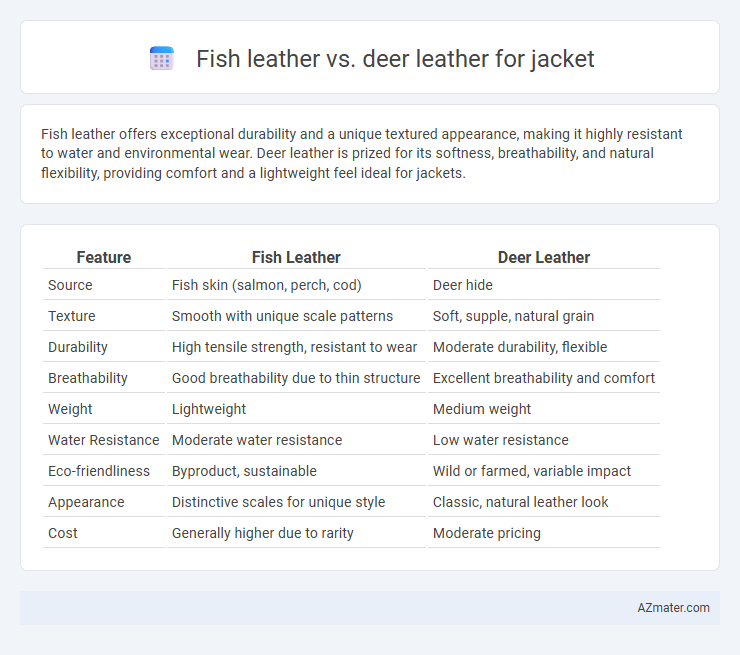Fish leather offers exceptional durability and a unique textured appearance, making it highly resistant to water and environmental wear. Deer leather is prized for its softness, breathability, and natural flexibility, providing comfort and a lightweight feel ideal for jackets.
Table of Comparison
| Feature | Fish Leather | Deer Leather |
|---|---|---|
| Source | Fish skin (salmon, perch, cod) | Deer hide |
| Texture | Smooth with unique scale patterns | Soft, supple, natural grain |
| Durability | High tensile strength, resistant to wear | Moderate durability, flexible |
| Breathability | Good breathability due to thin structure | Excellent breathability and comfort |
| Weight | Lightweight | Medium weight |
| Water Resistance | Moderate water resistance | Low water resistance |
| Eco-friendliness | Byproduct, sustainable | Wild or farmed, variable impact |
| Appearance | Distinctive scales for unique style | Classic, natural leather look |
| Cost | Generally higher due to rarity | Moderate pricing |
Introduction to Fish Leather and Deer Leather
Fish leather, derived from species such as salmon, cod, and perch, offers a unique texture and environmental benefits due to its sustainable sourcing from fish byproducts. Deer leather, known for its softness, durability, and flexibility, is traditionally used in jackets for its natural grain and insulating properties. Comparing fish and deer leather highlights differences in texture, durability, and ecological impact, influencing material choice for fashion and functionality in jackets.
Origin and Production Processes
Fish leather originates from species such as salmon, cod, and perch, harvested predominantly in Scandinavian and North American regions known for sustainable fishing industries. The production involves a meticulous tanning process where fish skins undergo thorough cleaning, descaling, and vegetable tanning to enhance durability and flexibility, preserving the distinctive scale patterns. Deer leather, sourced mainly from wild or farmed deer in North America and Europe, undergoes a traditional tanning process that emphasizes softness and breathability, often involving brain tanning or chrome tanning methods to maintain the natural grain and suppleness suitable for use in high-quality jackets.
Sustainability and Environmental Impact
Fish leather offers a highly sustainable alternative to traditional deer leather, as it utilizes byproducts from the fishing industry, significantly reducing waste and resource consumption. Unlike deer leather, which requires large land use, water, and feed resources for raising deer, fish leather production has a lower carbon footprint and minimizes deforestation and habitat disruption. The tanning process for fish leather also tends to use fewer toxic chemicals, enhancing its environmental benefits over conventional deer leather jackets.
Texture and Appearance Comparison
Fish leather exhibits a unique texture characterized by natural scale patterns that create a distinct, slightly rough surface, offering an eye-catching and exotic appearance for jackets. In contrast, deer leather features a soft, supple texture with a smooth grain that provides a luxurious and classic look ideal for stylish, comfortable outerwear. Both materials offer durability, but fish leather stands out with its glossy finish and intricate scale detail, while deer leather excels in flexibility and a matte, refined surface.
Durability and Longevity
Fish leather offers exceptional durability due to its unique collagen fiber structure, making it highly resistant to wear and tear compared to traditional leathers. Deer leather is known for its natural softness and flexibility but may show signs of aging faster under heavy use due to its thinner grain. For longevity, fish leather jackets typically maintain their integrity longer in harsh conditions, providing a rugged yet eco-friendly alternative to deer leather.
Comfort and Wearability Factors
Fish leather offers exceptional softness and flexibility due to its unique collagen fiber structure, making it highly comfortable for jacket wear. Deer leather, known for its durability and natural suppleness, provides excellent breathability and adapts well to body movements, enhancing overall wearability. Both leathers are lightweight, but fish leather's thinner texture makes it preferable for warmer climates, while deer leather suits colder conditions with its insulating properties.
Maintenance and Care Requirements
Fish leather requires regular conditioning with specialized oils to maintain its flexibility and prevent drying out, as it is more porous and delicate compared to deer leather. Deer leather is naturally softer and more durable, needing less frequent conditioning but benefits from occasional cleaning and waterproofing treatments to preserve its suppleness and resistance. Both leathers should be kept away from excessive moisture and direct sunlight to avoid damage and discoloration.
Cost and Market Availability
Fish leather, derived mainly from species like salmon and cod, tends to be more affordable due to its byproduct nature and increasing market availability in sustainable fashion. Deer leather, prized for its softness and durability, generally commands higher prices as it is less abundant and often sourced from specialized farms or hunters. Market availability for fish leather jackets is growing in niche eco-friendly markets, whereas deer leather jackets remain popular in traditional leather goods sectors but are more limited in supply.
Fashion Trends and Design Versatility
Fish leather offers a unique texture and natural patterns, making it a standout choice in fashion trends for jackets, appealing to eco-conscious consumers seeking sustainable alternatives. Deer leather is prized for its softness, durability, and versatility, enabling designers to create both rugged and refined jacket styles that maintain timeless appeal. While fish leather pushes innovative, statement-making designs, deer leather remains a classic favorite for its adaptability across various fashion aesthetics.
Choosing the Right Leather for Your Jacket
Fish leather offers exceptional durability and a unique textured appearance, making it a sustainable and exotic choice for jackets, ideal for those seeking eco-friendly fashion. Deer leather provides softness, flexibility, and natural breathability, perfect for comfortable, lightweight jackets that require high wearability. When choosing the right leather, consider the desired texture, durability, and ethical sourcing to match your style and functional needs.

Infographic: Fish leather vs Deer leather for Jacket
 azmater.com
azmater.com